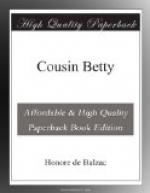Lisbeth Fischer, though the daughter of the eldest of the three brothers, was five years younger than Madame Hulot; she was far from being as handsome as her cousin, and had been desperately jealous of Adeline. Jealousy was the fundamental passion of this character, marked by eccentricities—a word invented by the English to describe the craziness not of the asylum, but of respectable households. A native of the Vosges, a peasant in the fullest sense of the word, lean, brown, with shining black hair and thick eyebrows joining in a tuft, with long, strong arms, thick feet, and some moles on her narrow simian face—such is a brief description of the elderly virgin.
The family, living all under one roof, had sacrificed the common-looking girl to the beauty, the bitter fruit to the splendid flower. Lisbeth worked in the fields, while her cousin was indulged; and one day, when they were alone together, she had tried to destroy Adeline’s nose, a truly Greek nose, which the old mothers admired. Though she was beaten for this misdeed, she persisted nevertheless in tearing the favorite’s gowns and crumpling her collars.
At the time of Adeline’s wonderful marriage, Lisbeth had bowed to fate, as Napoleon’s brothers and sisters bowed before the splendor of the throne and the force of authority.
Adeline, who was extremely sweet and kind, remembered Lisbeth when she found herself in Paris, and invited her there in 1809, intending to rescue her from poverty by finding her a husband. But seeing that it was impossible to marry the girl out of hand, with her black eyes and sooty brows, unable, too, to read or write, the Baron began by apprenticing her to a business; he placed her as a learner with the embroiderers to the Imperial Court, the well-known Pons Brothers.
Lisbeth, called Betty for short, having learned to embroider in gold and silver, and possessing all the energy of a mountain race, had determination enough to learn to read, write, and keep accounts; for her cousin the Baron had pointed out the necessity for these accomplishments if she hoped to set up in business as an embroiderer.
She was bent on making a fortune; in two years she was another creature. In 1811 the peasant woman had become a very presentable, skilled, and intelligent forewoman.
Her department, that of gold and silver lace-work, as it is called, included epaulettes, sword-knots, aiguillettes; in short, the immense mass of glittering ornaments that sparkled on the rich uniforms of the French army and civil officials. The Emperor, a true Italian in his love of dress, had overlaid the coats of all his servants with silver and gold, and the Empire included a hundred and thirty-three Departments. These ornaments, usually supplied to tailors who were solvent and wealthy paymasters, were a very secure branch of trade.




